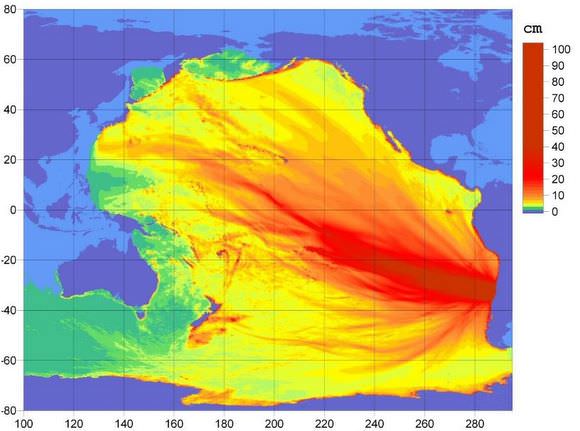[/caption]
A devastating magnitude-8.8 earthquake struck Chile early Saturday, shattering buildings and bridges, killing over 100 people and setting off a tsunami that threatens every nation around the Pacific Ocean — roughly a quarter of the globe. Experts warned that a tsunami could strike anywhere in the Pacific, and Hawaii could face its biggest tsunami since 1964. The Pacific Tsunami Warning Center predicts a possible 2.5 meter (8.2-foot) wave to strike Hilo, Hawaii, at 11:05 a.m. local time (4:05 p.m. ET).
The National Weather Service has issued a tsunami warning for the entire West Coast of the US, and is advising everyone in coastal counties to stay away from beaches and shorelines this afternoon when a tsunami producing strong currents and a series of potentially dangerous waves is expected to hit the coast at around 1:20 p.m PST.
Alaska is also threatened, and tsunami waves could possibly hit Asian, Australian and New Zealand shores within 24 hours of the earth quake. See the map above of the tsunami predicted paths.

The quake struck at 3:34 a.m. (1:34 a.m. EST, 0634 GMT) 200 miles (325 kilometers) southwest of Santiago.
Chilean TV showed devastating images of the most powerful quake to hit the country in a half-century: In the second city of Concepcion trucks plunged into the fractured earth, homes fell, bridges collapsed and buildings were engulfed in flames. Injured people lay in the streets or on stretchers.
Many roads were destroyed and electricity and water were cut to many areas.
Several astronomical observatories are located in Chile, and as of this writing, the word on Twitter is that Gemini South’s servers have come back online, but Cerro Tololo (CTIO) and SLOOH servers are down. No word on telescopes yet at Paranal, which is north of Santiago, Chile. From the ALMA crew at NRAO, “Reports from our people in Santiago are trickling in; so far everyone is ok, but quite rattled.”
Links of interest:
NOAA Pacific Tsunami Warning Center
Live streaming news from Hawaii
Estimated arrival times for tsunamis.


So many earthquakes lately
What to do, our Sun’s activity is toward its peak in this three years, sending more heat to our planet, boiling the ocean n trapped more heat, here comes El Nino, there comes a big quakes, hope no one will get injured.
Well i guess this is the price we pay for a geologically active planet, but its vital for our survival. my condolences to people who know people who lost there lives in this Earthquake, they just keep coming
I feel so sorry for the people that have to go all through this. On news I heard that many people got injusred and hurt. We are still Waiting for the Tsunami.
First In Haiti Now Chile !!!!
So far we’ve had a couple of waves up to 1-1.5m in various parts of NZ so far, however, it’s low tide at the moment, and it’s mostly just being classed as a ‘marine threat’, apart from, I think the Chatham Islands and banks peninsula.
An 8.8 — that is up there in scale. It is interesting though that the numbers of casualties are not terribly high, for Chile is essentially an OECD level nation. Haiti is near the bottom, and the consquences for their smaller quake was far more devistating.
LC
Yeah, I feel sorry for Chile,
I live in Hawaii and the Tsunami luckily turned out to not be that dangerous after all, but it was kinda cool to see all the water drain out from the bay and then rush back in.
Nancy,
Your article is correct but the map you used from the Sentinel is way off.
The epicenter was south of Santiago on the coast. The map you are showing refers to a much smaller earthquake that happened in the Atacama desert some years ago.
Patrick
BTW… I am from Concepcion…
This just in from ESO:
http://www.eso.org/public/events/announcements/ann1010/index.html
No damage to ESO observatories.
Thanks for the correction, Patrick. I’ve put in a new map.
Part of the reason for there being fewer casualties is due to the fact that the quake happened at a greater depth than the Haiti and Indonesian quakes – nealy 30 kilometers. Also of course Chile has a far better earthquake building code than Haiti.
P.s. It was also in shallower water. The waves propagated underground would have disipated somewhat before they reached the seabed and the ‘shallow’ water above would also have lessened the effects.